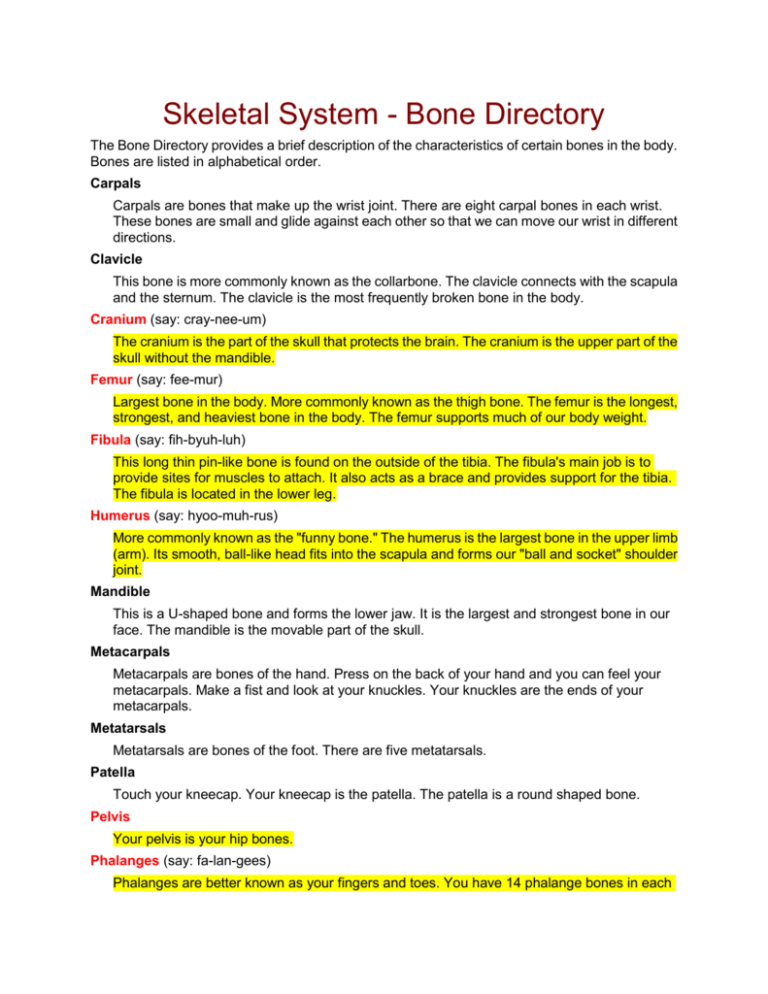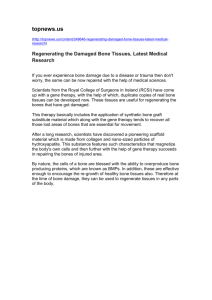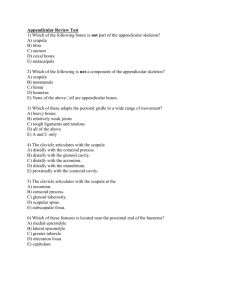Bones definitions
advertisement

Skeletal System - Bone Directory The Bone Directory provides a brief description of the characteristics of certain bones in the body. Bones are listed in alphabetical order. Carpals Carpals are bones that make up the wrist joint. There are eight carpal bones in each wrist. These bones are small and glide against each other so that we can move our wrist in different directions. Clavicle This bone is more commonly known as the collarbone. The clavicle connects with the scapula and the sternum. The clavicle is the most frequently broken bone in the body. Cranium (say: cray-nee-um) The cranium is the part of the skull that protects the brain. The cranium is the upper part of the skull without the mandible. Femur (say: fee-mur) Largest bone in the body. More commonly known as the thigh bone. The femur is the longest, strongest, and heaviest bone in the body. The femur supports much of our body weight. Fibula (say: fih-byuh-luh) This long thin pin-like bone is found on the outside of the tibia. The fibula's main job is to provide sites for muscles to attach. It also acts as a brace and provides support for the tibia. The fibula is located in the lower leg. Humerus (say: hyoo-muh-rus) More commonly known as the "funny bone." The humerus is the largest bone in the upper limb (arm). Its smooth, ball-like head fits into the scapula and forms our "ball and socket" shoulder joint. Mandible This is a U-shaped bone and forms the lower jaw. It is the largest and strongest bone in our face. The mandible is the movable part of the skull. Metacarpals Metacarpals are bones of the hand. Press on the back of your hand and you can feel your metacarpals. Make a fist and look at your knuckles. Your knuckles are the ends of your metacarpals. Metatarsals Metatarsals are bones of the foot. There are five metatarsals. Patella Touch your kneecap. Your kneecap is the patella. The patella is a round shaped bone. Pelvis Your pelvis is your hip bones. Phalanges (say: fa-lan-gees) Phalanges are better known as your fingers and toes. You have 14 phalange bones in each hand and 14 in each foot, for a GRAND TOTAL of... 56 phalanges! Radius (say: ray-dee-us) This is one of the two forearm bones. The forearm is the lower part of your arm from your wrist to your elbow. The radius is thinner near the elbow and gets thicker with a bulge near the wrist. Ribs You have twelve pairs of ribs. In the front of your body they attach to your sternum with flexible cartilage. In the back of your body they connect with the vertebrae. Your ribs are a bony cage that protects your heart and lungs. Scapula (say: sca-pyuh-luh) This thin, flattened, triangular bone is found on the back of the shoulder area. The scapula connects the clavicle to the humerus. The scapula is commonly called the "shoulder blade." Sternum (say: stur-num) More commonly known as the "breastbone." Located right in the middle of your chest. Tarsals These are the bones in your ankle. There are seven tarsal bones that allow for movement in the foot. Tibia (say: tih-bee-uh) This bone is also known as the shinbone. The tibia is the second largest bone in the skeleton and is found in the lower leg. The Tibia is very large at the top where it connects with the femur at the knee joint. Ulna (say: ul-nuh) The ulna is a long thin bone of the forearm. The top "wrench-like" end of the ulna is larger that the small, rounded end. It is next to the radius in the lower arm. Vertebrae (say: vur-tuh-bray) The vertebrae are the bones of the spine. There are 26 vertebrae. The top one is the atlas and the bottom one is the coccyx (say: cok-sicks). The vertebrae protect the spinal cord.










